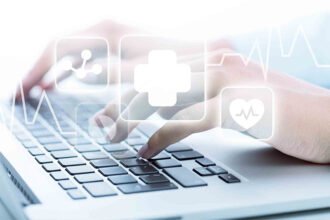When I was a medical student at Wake Forest University in the early 1990s I often had very full pockets in my short white coat. Here I carried all of the knowledge I could cram into a small black book. The contents of the book would change based on the rotation but the basics were always there. Calculations for drug doses, creatinine clearance, and treatment algorithms for common emergencies such as diabetic ketoacidosis (DKA).
When I was a medical student at Wake Forest University in the early 1990s I often had very full pockets in my short white coat. Here I carried all of the knowledge I could cram into a small black book. The contents of the book would change based on the rotation but the basics were always there. Calculations for drug doses, creatinine clearance, and treatment algorithms for common emergencies such as diabetic ketoacidosis (DKA). A small book for determining the correct antibiotic to use for a particular infection accompanied every medical student and resident in Internal Medicine. The notes and guidebooks followed me throughout my internship and residency as well as my fellowship. Over the years of my training my pockets grew heavy and the notes and books became tattered and worn. I still have a few of these items in my office today as a fond reminder of my years of training.
Eventually, during my cardiology fellowship training at Duke University Medical Center, the books and notes in my pocket began to slowly be replaced by a small computer called a Personal Digital Assistant or PDA. This gadget was bulky but powerful for its time; I was able to input many of my notes and calculations and eventually, the device interfaced with the hospital computer system. We were also given hand held ultrasound machines to use for the performance of bedside echocardiograms for rapid diagnosis of cardiovascular abnormalities. Ten years later, physicians in training interact with technology like never before. Use of mobile technology is the norm rather than the exception. Apps such as ePocrates and Evernote help create the digital black books of today’s physicians in training.
This week in the New York Times author Katie Hafner explores the changes in the way medical students and residents in training use technology. Ipads and iphones are utilized to access information instead of the bulky black book and notes that I once relied upon. Residents are able to quickly access information on rounds or while on call that allows them to better treat the patients they see. Medical applications for digital devices allow for quick calculations of drug doses and treatment algorithms. Laboratory data is wirelessly downloaded and readily available to housestaff as they care for patients. When I was in training and cared for a patient with a disease I had not yet encountered, I went to the resident’s library and read all about the disease , its signs and symptoms, its diagnosis and treatment in Harrison’s Textbook of Medicine . I would often then pull papers from the literature and read more about the disease in order to be well prepared for rounds the next morning. Technology now provides young physicians with the ability to research and learn “on the go”–often reading about the disease process on a smartphone while walking down the hallway to see another patient.
However, as described in the Times, technology has provided young doctors with new tools and the ability to communicate, consult, diagnose and treat patients. More senior clinicians worry that technology may create a barrier between patient and doctor. Many of these more seasoned clinicians struggle to balance technology and the art of physical diagnosis. In many leading academic teaching institutions, faculty attempt to preserve the art of medicine while integrating technology. The “greats” of medicine such as Sir William Osler, emphasized history and physical exam for bedside diagnosis. These “giants” of diagnostic medicine could detect the slightest abnormalities and make accurate diagnoses with nothing more than a touch or a brief listen with a stethoscope. For them, time spent talking with the patient was invaluable. Listening to the patient tell the “story” of their disease was essential to the art of medicine.
It is important that as young physicians are trained in the use of technology that they also are trained in the art of listening to the patient. Much of the art of medicine is derived from a relationship with the patient; that relationship is the result of time spent at the bedside, not in front of a computer screen. Technology plays a vital role in healthcare today and certainly makes medical care and medical education better. I am not quite sure what Dr. Osler would say about technologically savvy physicians were he alive today. I do know that he would continue to champion the comprehensive history and physical exam and use technology as a complementary tool. As medical descendants of Sir William Olser, (considered the Father of modern medicine) we must be good stewards of technology and use it to improve care. Our challenge, as physicians in a world filled with amazing technology, is to make sure that a computer screen or mobile device does not separate doctor from patient.







